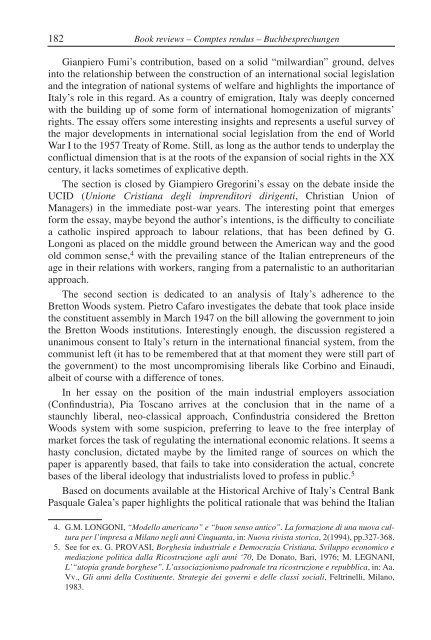2008, Volume 14, N°2 - Centre d'études et de recherches ...
2008, Volume 14, N°2 - Centre d'études et de recherches ...
2008, Volume 14, N°2 - Centre d'études et de recherches ...
Create successful ePaper yourself
Turn your PDF publications into a flip-book with our unique Google optimized e-Paper software.
182<br />
Book reviews – Comptes rendus – Buchbesprechungen<br />
Gianpiero Fumi’s contribution, based on a solid “milwardian” ground, <strong>de</strong>lves<br />
into the relationship b<strong>et</strong>ween the construction of an international social legislation<br />
and the integration of national systems of welfare and highlights the importance of<br />
Italy’s role in this regard. As a country of emigration, Italy was <strong>de</strong>eply concerned<br />
with the building up of some form of international homogenization of migrants’<br />
rights. The essay offers some interesting insights and represents a useful survey of<br />
the major <strong>de</strong>velopments in international social legislation from the end of World<br />
War I to the 1957 Treaty of Rome. Still, as long as the author tends to un<strong>de</strong>rplay the<br />
conflictual dimension that is at the roots of the expansion of social rights in the XX<br />
century, it lacks som<strong>et</strong>imes of explicative <strong>de</strong>pth.<br />
The section is closed by Giampiero Gregorini’s essay on the <strong>de</strong>bate insi<strong>de</strong> the<br />
UCID (Unione Cristiana <strong>de</strong>gli imprenditori dirigenti, Christian Union of<br />
Managers) in the immediate post-war years. The interesting point that emerges<br />
form the essay, maybe beyond the author’s intentions, is the difficulty to conciliate<br />
a catholic inspired approach to labour relations, that has been <strong>de</strong>fined by G.<br />
Longoni as placed on the middle ground b<strong>et</strong>ween the American way and the good<br />
old common sense, 4 with the prevailing stance of the Italian entrepreneurs of the<br />
age in their relations with workers, ranging from a paternalistic to an authoritarian<br />
approach.<br />
The second section is <strong>de</strong>dicated to an analysis of Italy’s adherence to the<br />
Br<strong>et</strong>ton Woods system. Pi<strong>et</strong>ro Cafaro investigates the <strong>de</strong>bate that took place insi<strong>de</strong><br />
the constituent assembly in March 1947 on the bill allowing the government to join<br />
the Br<strong>et</strong>ton Woods institutions. Interestingly enough, the discussion registered a<br />
unanimous consent to Italy’s r<strong>et</strong>urn in the international financial system, from the<br />
communist left (it has to be remembered that at that moment they were still part of<br />
the government) to the most uncompromising liberals like Corbino and Einaudi,<br />
albeit of course with a difference of tones.<br />
In her essay on the position of the main industrial employers association<br />
(Confindustria), Pia Toscano arrives at the conclusion that in the name of a<br />
staunchly liberal, neo-classical approach, Confindustria consi<strong>de</strong>red the Br<strong>et</strong>ton<br />
Woods system with some suspicion, preferring to leave to the free interplay of<br />
mark<strong>et</strong> forces the task of regulating the international economic relations. It seems a<br />
hasty conclusion, dictated maybe by the limited range of sources on which the<br />
paper is apparently based, that fails to take into consi<strong>de</strong>ration the actual, concr<strong>et</strong>e<br />
bases of the liberal i<strong>de</strong>ology that industrialists loved to profess in public. 5<br />
Based on documents available at the Historical Archive of Italy’s Central Bank<br />
Pasquale Galea’s paper highlights the political rationale that was behind the Italian<br />
4. G.M. LONGONI, “Mo<strong>de</strong>llo americano” e “buon senso antico”. La formazione di una nuova cultura<br />
per l’impresa a Milano negli anni Cinquanta, in: Nuova rivista storica, 2(1994), pp.327-368.<br />
5. See for ex. G. PROVASI, Borghesia industriale e Democrazia Cristiana. Sviluppo economico e<br />
mediazione politica dalla Ricostruzione agli anni ‘70, De Donato, Bari, 1976; M. LEGNANI,<br />
L’“utopia gran<strong>de</strong> borghese”. L’associazionismo padronale tra ricostruzione e repubblica, in: Aa.<br />
Vv., Gli anni <strong>de</strong>lla Costituente. Strategie <strong>de</strong>i governi e <strong>de</strong>lle classi sociali, Feltrinelli, Milano,<br />
1983.

















